IELTS Reading: strategies and techniques for all question types; with special tips for time management
In this IELTS Reading post, I’m discussing some strategies, easy steps, and techniques to answer every reading question type. IELTS Reading exam can be quite confusing in many cases and candidates complain about timing and getting confused most of the time. I’ll be looking at every question type from Cambridge IELTS Series books and present the strategies that I followed to score bandscore 8.0 in IELTS Reading. I’ll also share some special tips for time management in IELTS Reading in the end.
IELTS candidates should ask themselves a number of questions before they start practicing IELTS Reading.
- How much time do I invest in Reading English texts everyday?
- What types of reading texts make me feel comfortable? Which ones make me feel confused and irritated?
- Do I get confused while reading difficult words? Do I know enough synonyms? Or, is it the grammar? Is it the length of the text?
- Do I know what a KEYWORD or KEY PHRASE is?
- Do I know about different Reading skills?
- Do I know all the different question types in the IELTS Reading exam? Do I know about their settings and timing? Do I know how to answer them effectively?
Here are some response-based tips according to the questions above:
- If the answer is one hour or more, you are doing great. If the answer is less than one hour, please make it at least one hour everyday. I know it’s boring; I know it’s irritating; I know you don’t like it but there’s no other option. YOU MUST READ TO GET A GOOD SCORE IN READING!
- If you feel comfortable reading difficult topics such as research, psychology, global problems, etc. you are on the right track. You may feel confused reading those, but my suggestion for you is to get used to with those as they are quite common in the IELTS Reading exam. They may help you IELTS Writing, Listening and Speaking too.
- Vocabulary and grammar should also be improved from your part as much as you can. When you improve your vocabulary, you improve your stock of synonyms too. If you improve your word-stock and grammar base; the chance of earning a great band in IELTS Reading will increase rapidly. Invest some time each week to learn some new English vocabulary and grammar. You can follow any good vocabulary book and any grammar book to do so.
- A KEYWORD or KEY PHRASE is a word or phrase that is a part of a question that can lead us to find the answer. You should learn how to find a keyword from the question very quickly.
- The most important reading skills for any exam are skimming (reading quickly to locate the main idea), scanning (reading quickly to find factual information), previewing (getting an idea about the text by looking at the heading, the layout and images only), guessing words from context (guessing an unknown word using the words around and other information in the text) and understanding opinions and attitudes (understanding what the writer of the text feels about the discussed topic). You should invest some time to practice these skills from different texts and questions.
- There are 12-14 different question types in the IELTS Reading exam and you must learn to recognize every question, how they should be answered and how much time you should put in to answer them.
How to find a KEYWORD or KEY PHRASE:
As I’ve mentioned in point no. 4, a KEYWORD or KEY PHRASE is a word or phrase that is a part of a question head that can lead us to the correct answer. They are the words that carry specific information.
Which words can be KEYWORDS?
- Nouns and Verbs
- Names (places, scientists, people and more included in the passage)
- Locations (towns, cities, states, countries…)
- Dates and Years
- Numbers or Figures
- Capitalized or Italicized words/phrases
Locating a keyword correctly needs practice and some time.
Let’s have a look at the following text and find the KEYWORDS or KEY PHRASES. We’ll try to answer them according to the KEYWORDS or KEYPHRASES.
Read this short text and find the keywords for the given questions. ![]() 2 minutes
2 minutes
Desert: A place of extreme
Hardly any places on earth are as bleak and hostile as a desert. Deserts are those enormous areas where very little rain falls – on average less than 100 mm (3.9 inches) a year. Any rain that does fall quickly fades away. Few plants can stay alive, and soil cannot develop in such a dry and barren or arid atmosphere. The scenery in a desert is bare sand, gravel, or rock. Clear skies and sparse vegetation leave the ground exposed to a tremendous amount of temperature. In the tropics, clear skies generate boiling hot deserts with daytime temperatures which are often over 50°C (122°F). Deserts at higher latitudes can have a reverse atmosphere with extreme cold.
Now, answer the following questions. Use NO MORE THAN TWO WORDS for each answer. The first one is done for you.
- Deserts are those massive areas where ________ is rare.
(What are the keywords for this question?)
Deserts are those massive areas where ________ is rare.
So, we need to find the phrase ‘massive areas’ and the word ‘rare’.
Let’s find them in the text. Take a look at the first few lines:
Hardly any places on earth are as stark and hostile as a desert. Deserts are those enormous areas where very little rain falls.
Here, enormous areas = massive areas, very little = rare,
Answer: rain
Now, you should try the next two questions yourself. Find the answers at the end of the post.
- What cannot mature in deserts?
(What are the keywords for this question? Underline them with a pencil.)
Answer:
- What is the frequent temperature of deserts in the tropics?
(What are the keywords for this question? Underline them with a pencil.)
Answer:
I hope you can find texts and questions of your own which you can use to practice finding KEYWORDS and KEY PHRASES.
Question types:
There are around 12/13 questions in the IELTS Reading exam. We shall be looking at all the IELTS Reading questions from Cambridge Series books to learn the strategies to answer them correctly and effectively. Let’s begin!
Type 1: Multiple choice questions / MCQs
One of the most common sets of questions that we may get in the exam is Multiple Choice Questions. I think most of us can easily identify them easily as it contains a question head and three or four answer options. We have to choose the correct answer to the question from the given options.
Now, this question has an advantage. It will follow a sequence. This means all the questions in this question type can be found in the text sequentially.
The disadvantages of the question re that the answer options can be quite long in Reading Passage 2 or 3 and two answer options can be quite similar. So, this may kill valuable time.
Here are the strategies that I follow to answer this type of questions:
- Read the questions carefully and mark the KEYWORDS.
- Don’t read the answer options if they are too long. Go to the text and find the KEYWORDS (remember that some of the KEYWORDS can be in synonyms).
- Read the lines carefully and match them with the answer option.
- Decide on the best option keeping the synonyms and meaning in mind.
- Don’t panic if you don’t find the answer to the first question. As the question follows a sequence, you can go to the next questions and then come back to the first one later.
Let’s do a short practice from Cambridge 12 Test 7:
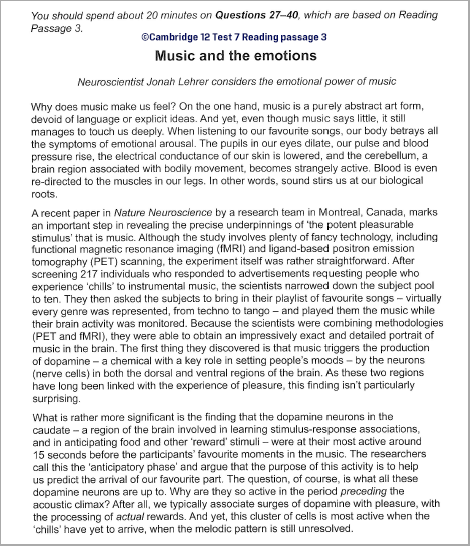
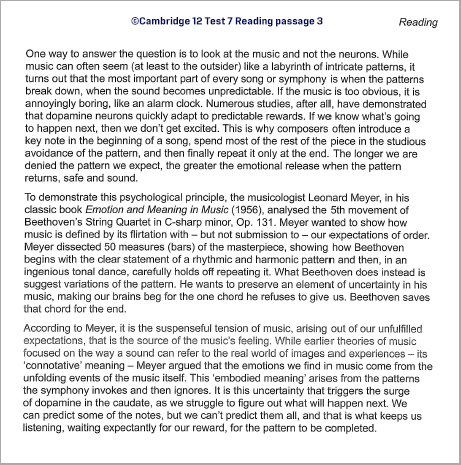
Here are some MCQs from the test for this passage:
Choose the correct letter, A, B, C or D.
1. What point does the writer emphasise in the first paragraph?
A. how dramatically our reactions to music can vary
B. how intense our physical responses to music can be
C. how little we know about the way that music affects us
D. how much music can tell us about how our brains operate
2. What view of the Montreal study does the writer express in the second paragraph?
A. Its aims were innovative.
B. The approach was too simplistic.
C. It produced some remarkably precise data.
D. The technology used was unnecessarily complex.
3. What does the writer find interesting about the results of the Montreal study?
A. the timing of participants’ neural responses to the music
B. the impact of the music on participants’ emotional state
C. the section of participants’ brains which was activated by the music
D. the type of music which had the strongest effect on participants’ brains
4. Why does the writer refer to Meyer’s work on music and emotion?
A. to propose an original theory about the subject
B. to offer support for the findings of the Montreal study
C. to recommend the need for further research into the subject
D. to present a view which opposes that of the Montreal researchers
5. According to Leonard Meyer, what causes the listener’s emotional response to music?
A. the way that the music evokes poignant memories in the listener
B. the association of certain musical chords with certain feelings
C. the listener’s sympathy with the composer’s intentions
D. the internal structure of the musical composition
I’m going to help you with the first one; you have to do the rest. OK?
1. What point does the writer emphasise in the first paragraph?
A. how dramatically our reactions to music can vary
B. how intense our physical responses to music can be
C. how little we know about the way that music affects us
D. how much music can tell us about how our brains operate
Keywords for this question: emphasise, first paragraph
We have to use our skimming skills here. Let’s have a quick look at paragraph 1 and see if we can find any similarities between one of the options and any lines in the paragraph.
In lines 2 and 3 of the first paragraph, the writer says, “And yet, even though music says little, it manages to touch us deeply.” After that, the writer gives a detail description of different body parts reacting extremely— “The pupils in our eyes dilate, our pulse and blood pressure rise, …. . .. . . .”. And the last line, “… .. . sound stirs us at our biological roots.” means that the sound of music touches us very intensely.
So, the answer is: B
Remember, the rest of the questions will follow a sequence. Try to answer them accordingly. Don’t look at the answers now. Find the answers at the end of the post when you are done with the questions.
Type 2: Short answer to open questions
Short answer questions are another set of very common questions in the IELTS exam. In this kind of question, candidates have to answer some questions, only with some conditions like NO MORE THAN THREE/TWO WORDS and/or A NUMBER or, ONE WORD ONLY. Each question has keywords that will lead to the answer. This question type generally follows a sequence. Surely, the KEYWORDS will be in the text as SYNONYMS.
Here are the strategies that I follow to answer this type of questions:
- Read the questions and mark the KEYWORDS or KEY PHRASES.
- Go to the text and find the KEYWORDS (remember that some of the KEYWORDS can be in synonyms).
- Read the lines carefully and match them with the answer option. Most of the answers will be pretty straightforward.
- Don’t panic if you don’t find the answer to the first question. As the question follows a sequence, you can go to the next questions and then come back to the first question later.
Let’s do a short practice from Cambridge 10 Test 1:
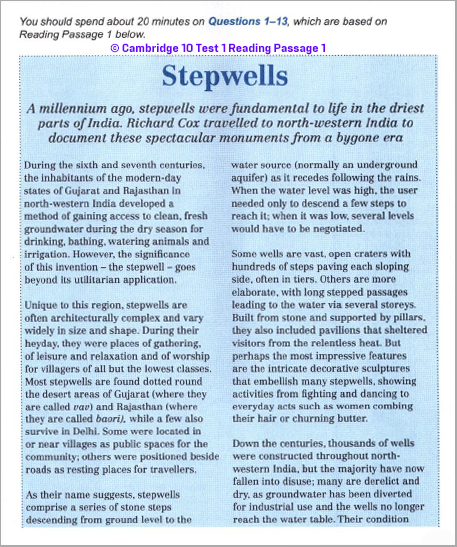
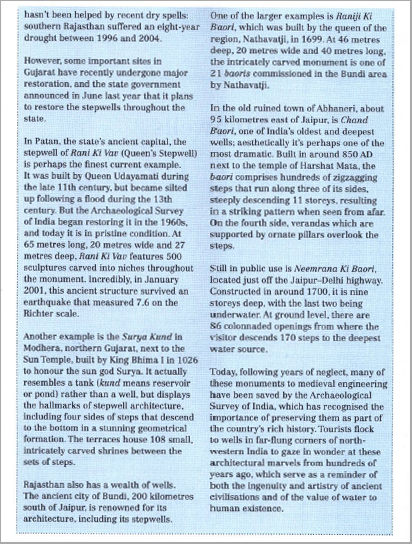


Let’s have a look at the questions:
Answer the questions below. Choose ONE WORD ONLY from the passage for each answer.
- Which part of some stepwells provided shade for people?
- What type of serious climatic event, which took place in southern Rajasthan, is mentioned in the article?
- Who are frequent visitors to stepwells nowadays?
I’m going to help you with the first one; you have to do the rest. OK?
- Which part of some stepwells provided shade for people?
Keywords for this question: Which part, shade, for people,
The answers can be found in lines 6-8 of paragraph no. 4, where the writer says, “Built from stone and supported by pillars, they also included pavilions that sheltered visitors from the relentless heat.”
Here, sheltered visitors from the relentless heat = provided shade for the people,
So, the answer is: pavilions
Remember, the rest of the questions will follow a sequence. Try to answer them accordingly. Don’t look at the answers now. Find the answers at the end of the post when you are done with the questions.
Type 3: TRUE, FALSE, NOT GIVEN / YES, NO, NOT GIVEN
Both TRUE, FALSE, NOT GIVEN and YES, NO, NOT GIVEN are the same types of questions with the exception that YES, NO, NOT GIVEN are given mainly based on the comments, opinions, and attitudes of people in the text.
In this type of question, candidates are asked to find out whether:
If the statement in the question agrees with the information in the passage – TRUE
If the statement in the question contradicts with the information in the passage – FALSE
If there is no information on this – NOT GIVEN
Or,
If the statement in the question matches with the claim of the writer in the text- YES
If the statement in the question contradicts with the claim of the writer in the text- NO
If the statement in the question has no clear connection with the account in the text- NOT GIVEN
Here are the strategies that I follow to answer this type of questions:
- Read the questions and mark the KEYWORDS or KEY PHRASES. For this type of question, you can find three sets of KEYWORDS in the text. (Have a close look at the example question that I’ve done for you.)
- Go to the text and find the KEYWORDS (remember that some of the KEYWORDS will be in synonyms).
- Read the lines carefully and match with the question.
- Don’t panic if you don’t find the answer to the first question. As this question type follows a sequence, you can go to the next questions and then come back to the first question later.
Let’s do a short practice from Cambridge 10 Test 1:






Let’s have a look at the questions:
- Examples of ancient stepwells can be found all over the world.
- Stepwells had a range of functions, in addition to those related to water collection.
- The few existing stepwells in Delhi are more attractive than those found elsewhere.
- It took workers many years to build the stone steps characteristic of stepwells.
- The number of steps above the water level in a stepwell altered during the course of a year.
I’m going to show you a special technique that I follow to answer TRUE, FALSE, NOT GIVEN or YES, NO, NOT GIVEN. In my opinion, you will be able to answer 90% of this kind of questions using this method. I named it ‘Method 3210’.
In this technique, I shall divide each of the questions in three individual parts.
If all the 3 parts in the question agree with the information in the passage – TRUE
If any 2 parts in the question agree but one part contradicts with the information in the passage – FALSE
If 1part in the question agrees but two parts / three parts disagrees on this/ If the main keyword doesn’t match – NOT GIVEN
I’m going to help you do 3 of the questions here.
Let’s have a look at question no. 1:
Examples of ancient stepwells can be found all over the world.
So, we have to match these 3 marked parts with the text.
Let’s take a look at the text:
The answer can be found in paragraph 2 lines 7-11 says, “Most stepwells are found dotted round the desert areas of Gujarat (where they are called vav) and Rajasthan (where they are called baori), while a few also survive in Delhi.”
This means that stepwells are unique to India, so they cannot be found all around the world.
Here, in these lines, Examples of ancient stepwells and can be found are mentioned. However, the question says they are found all over the world but the text mentions three places in India (Gujarat, Rajasthan and Delhi). So, this part doesn’t match.
So, we have 2 parts matched but 1 part unmatched.
So, the answers are: FALSE
Let’s do another. Let’s have a look at question no. 2:
Stepwells had a range of functions, in addition to those related to water collection.
In the first paragraph, the main function of stepwells are given in the description in lines 5-8, “ . .. . a method of gaining access to clean, fresh groundwater during the dry season for drinking, bathing, watering animals and irrigation. … .. .”
Here, gaining access to clean, fresh groundwater = water collection
However, the answer can be found in paragraph 2 lines 11-14 says, “Some were located in or near villages as public spaces for the community; others were positioned beside roads as
resting places for travelers.”
In the same paragraph, the writer also says in the previous lines, “During their heyday, they (stepwells) were places of gathering, of leisure and relaxation and of worship for villagers of all but the lowest classes.”
This means stepwells were used not only used for water collection but also as resting places for travelers and a place of gathering, of leisure and relaxation and of worship for villagers of all but the lowest classes.
Here, places of gathering, of leisure and relaxation and of worship, as resting places for travelers = other functions in addition to water collection,
So, we have all 3 parts matched.
So, the answers are: TRUE
Let’s do one more question. Let’s have a look at question no. 3:
The few existing stepwells in Delhi are more attractive than those found elsewhere.
Here, our main KEY PHRASE is more attractive. This suggests the point that we have to find a comparison on the attractiveness of stepwells in Delhi and other stepwells.
However, we find the mention of stepwells in Delhi in paragraph no. 2 lines 7-11 says, “Most stepwells are found dotted round the desert areas of Gujarat (where they are called vav) and Rajasthan (where they are called baori), while a few also survive in Delhi.”
But no comparison has been included anywhere in the text.
So, the answer is: NOT GIVEN
N.B.: I’m not saying that the technique will help everyone. It needs quite a bit of practice and a good understanding of how to divide the questions into three individual parts. You can also find the answers based on keywords only.
Remember, the rest of the questions will follow a sequence. Try to answer them accordingly. Don’t look at the answers now. Find the answers at the end of the post when you are done with the questions.
Type 4: List of headings / Matching Headings
This is one of the most time-consuming questions in the IELTS Reading exam.
In this question type, IELTS candidates are provided with a list of headings, usually identified with lower-case Roman numerals (i, ii, iii, etc,). A heading will refer to the main idea of the paragraph or section of the text. Candidates must find out the equivalent heading to the correct paragraphs or sections, which are marked with alphabets A, B, C and so forth. Candidates need to write the appropriate Roman numerals in the boxes on their answer sheets. There will always be two or three more headings than there are paragraphs or sections. So, some of the headings will not be used. It is also likely that some paragraphs or sections may not be included in the task. Generally, the first paragraph is an example paragraph that will be done for the candidates for their understanding of the task.
Here are the strategies that I follow to answer this type of questions:
- Don’t read the headings first; go straight to the passage and start reading from the paragraphs.
- Read the first and last few lines of the paragraphs and try to find the main topic / most important information of the paragraph.
- Remember to match important synonyms with the list of headings given in the questions.
- Eliminate any answer that doesn’t match with the paragraph.
- Don’t panic if you don’t find the answer to the first question. As the question follows a sequence, you can go to the next questions and then come back to the first question later.
- Remember you need to understand the theme of the paragraph, so reading skills like skimming and predicting will come in handy. You need not understand every word here. Just try to gather the gist of the sentences. That’s all. Read quickly and don’t stop until you finish each sentence.
- Sometimes the answer is in the last lines too. So, be careful to check that.
- Some questions will force you to read the middle part of the paragraphs. If that situation arises, do that at the end.
Let’s do a short practice from Cambridge 9 Test 4:




Let’s have a look at the questions now:
Choose the correct headings for paragraphs B-E from the list of headings (i-vii) below.
- Paragraph B
- Paragraph C
- Paragraph D
- Paragraph E
List of headings:
i. Commercial pressures on people in charge
ii. Mixed views on current changes to museums
iii. Interpreting the facts to meet visitor expectations
iv. The international dimension
v. Collections of factual evidence
vi. Fewer differences between public attractions
vii. Current reviews and suggestions
If you look closely at the questions, you will see that I’ve crossed out answer option v. Collections of factual evidence. This is because this option is given as an example answer for Paragraph A. You must do the same for the List of Headings questions that you may have in your exam because this answer will not be needed.
Now, let’s try to answer the first question; you can answer the rest of the questions yourself. Remember to resist yourself from reading the list of headings first. Match the answers
In paragraph B, the author first says in line no. 1, “Recently, attitudes towards history and the way it should be presented have altered.” After that, he presents some examples of changes to museums in Britain (UK) and (America) US.
Here, have altered = current changes,
And then, he explains the fact that, though many of the historical theme parks and museums are successful in “ . .. . the re-enactment of historical events is increasingly popular, ….”, these developments have been criticized as an intolerable vulgarisation. However, the last lines say, “. . . but the success of many historical theme parks and similar locations suggest that the majority of public does not share this opinion.”
Here, does not share this opinion = mixed views,
This means people have mixed views on the recent changes to museums.
As you can see, for this question, the first and last lines indicate the answer.
So, the answer is: ii (Mixed views on current changes to museums)
Remember, the rest of the questions will follow a sequence. Try to answer them accordingly. Don’t look at the answers now. Find the answers at the end of the post when you are done with the questions.
Type 5: Completing sentences with NO MORE THAN TWO/THREE WORDS and/or A NUMBER / ONE WORD ONLY:
In this type of question, candidates are asked to write a maximum of two/three words and/or a number / one word only to complete sentences on the given topic. For this type of question, first, skim the passage to find the keywords in the paragraph concerning with the answer, and then scan to find the exact word.
[TIPS: Here skimming and scanning technique will come in handy. Target the keywords of the questions to find the answers. Remember to focus on Proper nouns, random Capital letters, numbers, special characters of text etc.]
Here are the strategies that I follow to answer this type of questions:
- Read the questions first; (one great technique to save time here is to read two or three questions at a time if you have poor skills in reading. You can do individual questions too.)
- Skim to find the KEYWORDS / KEY PHRASES of the questions (look for synonyms).
- Now, scan to write down the correct answer according to the given condition.
- Don’t panic if you don’t find the answer to the first question. As the question follows a sequence, you can go to the next questions and then come back to the first question later.
Let’s do a short practice from Cambridge 7 Test 1:



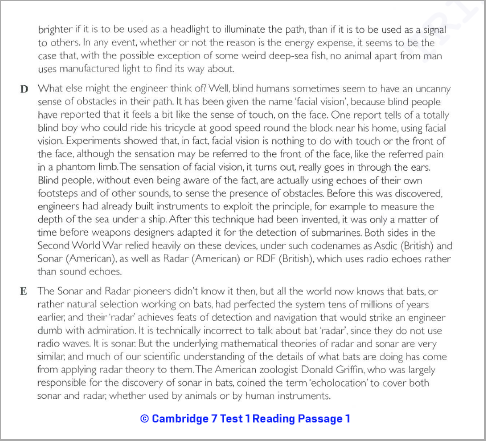


Let’s have a look at the questions now:
Complete the sentences below. Choose NO MORE THAN TWO WORDS from the passage for each answer.
- Long before the invention of radar, ___________ had resulted in a sophisticated radar-like system in bats.
- Radar is an inaccurate term when referring to bats because __________ are not used in their navigation system.
- Radar and sonar are based on similar ___________.
- The word ‘echolocation’ was first used by someone working as a ___________.
I’m helping you do the first question. You have to do the rest of the questions yourself.
- Long before the invention of radar, ___________ had resulted in a sophisticated radar-like system in bats.
Keywords for the question: long before, invention, radar, resulted in, radar-like system, bats,
Let’s try to find the answer from the text:
In paragraph E lines 1-3, the author mentions, “The Sonar and Radar pioneers didn’t know it then, but all the world now knows that bats, or rather natural selection working on bats, had perfected the system tens of millions of years earlier; and their ‘radar’ achieves feats of detection and navigation that would strike an engineer dumb with admiration.”
Here, millions of years earlier = long before, The Sonar and Radar pioneers didn’t know it then = before the invention of radar, had perfected = had resulted, the system = radar-like system,
So, the answer is: natural selection
Remember, the rest of the questions will follow a sequence. Try to answer them accordingly. Don’t look at the answers now. Find the answers at the end of the post when you are done with the questions.
Type 6: Identifying information
Many candidates consider this type as one of the most confusing questions.
This question asks you to find information from the passage and write the number of the paragraph (A, B, C or D .. .. ) in the answer sheet. There will be a note that says (N.B. You may use any letter more than once.)
TIPS: If the question is given in the very first part of the questions section in the exam paper, I’d request you not to answer them. It’s mainly because this question will not follow any sequence, and so it will surely kill your time. Rather, you should answer all the other questions first.
And just like List of Headings, only read the first lines or last lines of the expected paragraph initially. If you find the answers, you need not read the middle part. If you don’t find answers yet, you can skim the middle part of the paragraph. Keywords will be a useful matter here.
Here are the strategies that I follow to answer this type of questions:
- Read three questions at a time because you never know which one will pop out in paragraph A, B or C. So, to save your time, you must read two or three questions.
- Go to paragraph A, B, and C to find a match with any of the three questions. Read the first lines. If no match is found, read the last lines. Look for synonyms. (I know it’s hard; but hey! I managed to do this, and trust me, YOU CAN TOO.)
- When you are absolutely sure about any of the answers, cross it out with the pencil in the questions section. Then, go for the next questions.
Let’s do a short practice from Cambridge 7 Test 1:






Here are the questions from the exercise:
Which paragraph contains the following information?
- examples of wildlife other than bats which do not rely on vision to navigate by
- how early mammals avoided dying out
- why bats hunt in the dark
- how a particular discovery has helped our understanding of bats
- early military uses of echolocation
I’m helping you do the first question. You have to do the rest of the questions on your own, OK?
- examples of wildlife other than bats which do not rely on vision to navigate by
Keywords for the question: wildlife other than bats, do not rely on, vision, to navigate
In paragraph B, the author says in lines 3-4, “Obviously, the night-flying insects that they prey on must find their way about somehow. Deep-sea fish and whales have little or no light by day or by night. Fish and dolphins that live in extremely muddy water cannot see because, although there is light, it is obstructed and scattered”
Here, the writer talks about other insects and animals which don’t depend on eyesight, e.g. night flying insects, Deep-sea fish and whales, fish and dolphins who don’t depend on (rely on) vision to navigate by.
So, the answer is: B
Remember, the rest of the questions will not follow a sequence. Try to answer them accordingly as explained above in the strategies. Don’t look at the answers now. Find the answers at the end of the post when you are done with the questions.
Type 7: Classifying information with correct group / Matching reference
This is another set of questions that don’t follow any sequence. So, there’s a chance of killing time here, if you don’t answer them intelligently.
This type of question asks candidates to classify information from the given reading text. Candidates are given some statements from the text, and a list of options, which are listed as A, B, C etc. They must match the correct statements with the correct group.
Here are the strategies that I follow to answer this type of questions:
- Read three questions at a time because you never know which one will pop out in paragraphs A, B or C as they don’t follow any sequence. So, to save your time, you must read two or three questions.
- Go to paragraph A, B, and C to find a match with any of the three questions.
- First, skim for KEYWORDS and then scan for the information carefully. Look for synonyms.
- Then, go for the next questions.
Let’s do a short practice from Cambridge 8 Test 1:
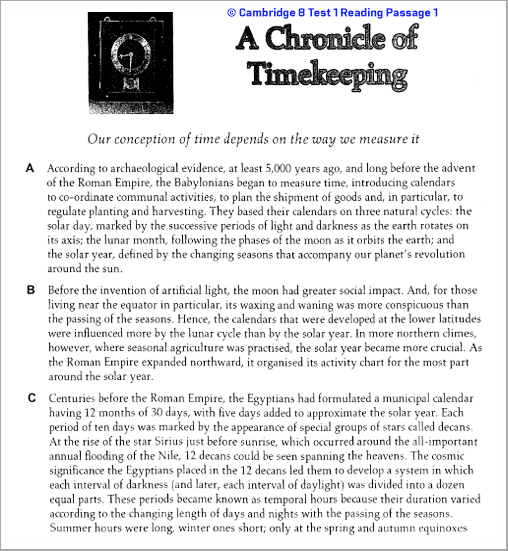


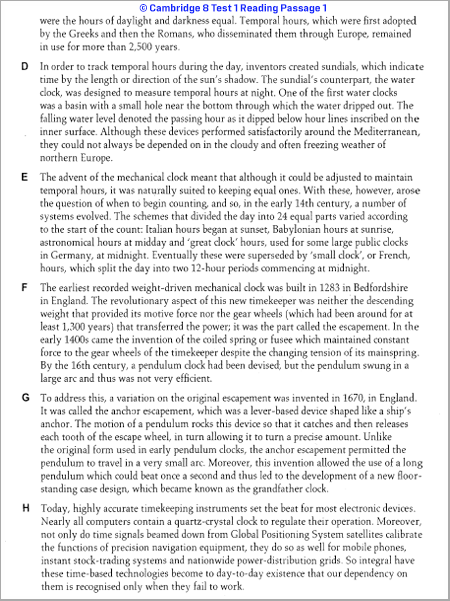


Here are the questions from the exercise:
Match each event with the correct nationality, A-F.
- They devised a civil calendar in which the months were equal in length.
- They divided the day into two equal halves.
- They developed a new cabinet shape for a type of timekeeper.
- They created a calendar to organize public events and work schedules.
List of Nationalities:
A. Babylonians
B. Egyptians
C. Greeks
D. English
E. Germans
F. French
Let’s do the first question together. Then, you can do the rest of the questions on your own.
- They devised a civil calendar in which the months were equal in length.
Keywords for the question: civil calendar, months, equal in length,
In paragraph C, the writer describes in the beginning, “Centuries before the Roman Empire, the Egyptians had formulated a municipal calendar having 12 months of 30 days, with five days added to approximate the solar year.”
Here, devised means formulated, civil means municipal, the months were equal in length means 12 months of 30 days,
This means the Egyptians devised the civil calendar in which the months were equal.
So, the answer is: B (Egyptians)
Remember, the rest of the questions will not follow a sequence. Try to answer them accordingly as explained above in the strategies. Don’t look at the answers now. Find the answers at the end of the post when you are done with the questions.
Type 8: Completing table/ Completing notes
Completing table and completing notes are more like filling in the blanks (as in Completing sentences). This is because you don’t need to complete the whole table or the notes; you need to fill in the blanks with NO MORE THAN TWO/ THREE WORDS and/or A NUMBER / ONE WORD ONLY.
To answer these types of questions, the strategies are just like in question type 5 discussed above.
Here are the strategies that I follow to answer this type of questions:
- Read the questions first; (one great technique to save time here is to read two or three questions at a time if you have poor skills in reading. You can do individual questions too.)
- Skim to find the KEYWORDS / KEY PHRASES of the questions (look for synonyms).
- Now, scan to write down the correct answer according to the given condition.
- Don’t panic if you don’t find answer to the first question. As the question follows sequence, you can go to the next questions and then come back to the first question later.
Let’s do a short practice from Cambridge 13 Test 3:




Let’s take a look at the questions from the exercise:


Let’s do the first question together:
- timber for houses and the making of _________
Keywords for these answers: trunk, 30 metres, houses, making of,
If you look closely, you will see that I’ve added a word like ‘trunk’ and a phrase like ‘30 metres’ as the KEYWORDs. This is because they appear in the same row which means they may direct us to the answer.
Now, to locate the answer to this question, we need to locate the keyword ‘trunk’ which can be found in paragraph no. 2, line no. 3. Here, the author writes, “ … . The coconut palm has a smooth, slender, grey trunk, up to 30 metres tall. This is an important source of timber for building houses, and is increasingly being used as a replacement for endangered hardwoods in the furniture construction industry.”
Here, construction = making of,
So, the lines say that the trunk of a coconut tree is used not only in making the timbers for houses but also in making furniture.
So, the answer is: furniture
Remember, the rest of the questions will follow a sequence. Try to answer them accordingly as explained above in the strategies. Don’t look at the answers now. Find the answers at the end of the post when you are done with the questions.
Type 9: Summary completion
In this kind of questions, candidates are given a summary for one, two or three paragraphs with some fill in the blanks questions. Candidates need to find out the related paragraphs by correctly studying the keywords form the questions. Then, they should follow the steps of finding answers to fill in the gaps. Sometimes, the answers can be given as a ‘list of words’ with the questions. Candidates must write the correct letter (not the words) as the answers in this case. Here, synonyms are important to find answers correctly.
Here are the strategies that I follow to answer this type of questions:
- Read the questions first; (one great technique to save time here is to read two or three questions at a time if you have poor skills in reading. You can do individual questions too.) Always follow if there is a title of the summary because the title can guide us to the concerning paragraphs.
- Skim to find the KEYWORDS / KEY PHRASES of the questions (look for synonyms to match words if there is a ‘list of words’).
- Now, scan to write down the correct answer according to the given condition.
- Don’t panic if you don’t find the answer to the first question. As the question follows a sequence, you can go to the next questions and then come back to the first question later.
Let’s do a short practice from Cambridge 13 Test 2:
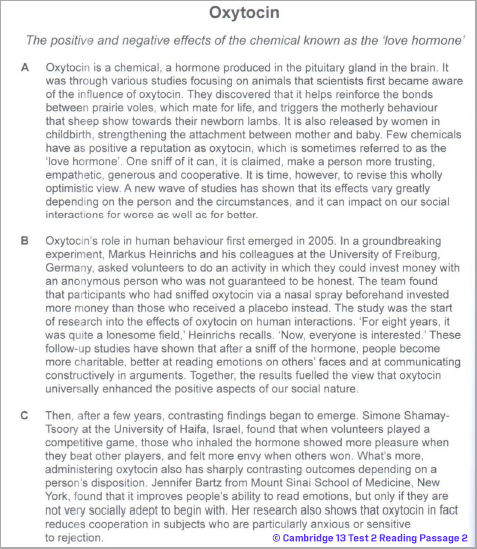



Let’s have a look at the questions from the exercise:
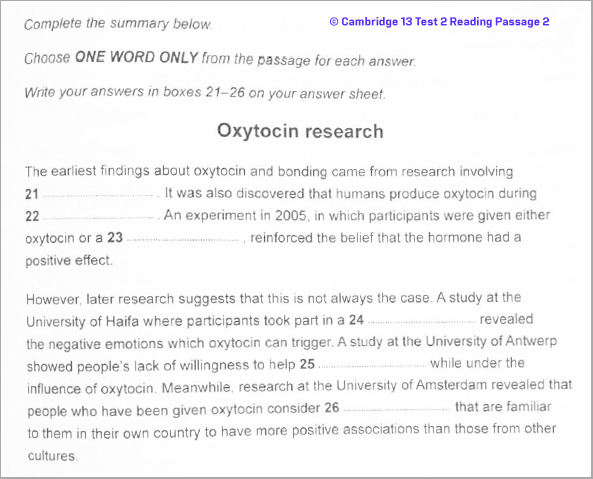

I’ll help you do the first question. Then, you will try to do the rest of the questions.
However, before doing that, let’s have a look at the question. Can you see a title ‘Oxytocin research’? This could guide us to the correct section where we can start looking for the answers.
- The earliest findings about oxytocin and bonding came from research involving _______.
Keywords for this question: earliest findings, came from, involving,
The answer to this question can be found at the very beginning of the passage. In Paragraph A lines 2-3, the author says, “.. . .. . . It was through various studies focusing on animals that scientists first became aware of the influence of oxytocin.”
Here, studies = research, Scientists first became aware = earliest findings,
So, the answer is: animals
Remember, the rest of the questions will follow a sequence. Try to answer them accordingly as explained above in the strategies. Don’t look at the answers now. Find the answers at the end of the post when you are done with the questions.
Type 10: Labeling diagram
In this type of question, candidates are asked to label a diagram with NO MORE THAN TWO/ THREE WORDS and /or A NUMBER / ONE WORD ONLY from the passage. Keywords are important to find answers correctly. Generally, this type of question maintains a sequence but this is not always the case. Find the keywords in the passage and you are most likely to find the answers.
The good bit about this type of question is that it can be found in ONE PARAGRAPH (90% times).
Here are the strategies that I follow to answer this type of questions:
- Read the questions and see if there’s a title. The title will always lead you to the concerning paragraph where you will find all the answers.
- Also, take a look at the diagram closely. Sometimes you have to think of some words for the different parts of the picture given.
- Look for the KEYWORDS and find the synonyms.
- Find one of the answers and the rest will come out easily. Remember, all the answers will be very close, probably in one paragraph. So, it will be quite easy for you to answer.
Let’s do a short practice from Cambridge 8 Test 1:






Let’s take a look at the questions from the exercise:


I’ll help you do the first question. Then, you will try to do the rest of the questions yourself.
- escapement (resembling __________ )
Keywords for this question: escapement, resembling,
In paragraph G, the writer says in lines 2-3, “.. . . . It was called the anchor escapement, which was a lever-based device shaped like a ship’s anchor.. . .”
Here, shaped like = resembling,
So, the answer to question no. 9 is: (ship’s) anchor
Remember, the rest of the questions will follow a sequence. Try to answer them accordingly as explained above in the strategies. Don’t look at the answers now. Find the answers at the end of the post when you are done with the questions.
Type 11: Completing flow-chart
In this type of question, candidates are asked to write NO MORE THAN TWO/THREE WORDS and/or A NUMBER / ONE WORD ONLY to complete some notes on the given flow-chart
The strategies to find the answers will be as it is for ‘Completing notes/ table’.
Here are the strategies that I follow to answer this type of questions:
- Read the questions first; (one great technique to save time here is to read two or three questions at a time if you have poor skills in reading. You can do individual questions too.)
- Skim to find the KEYWORDS / KEY PHRASES of the questions (look for synonyms).
- Now, scan to write down the correct answer according to the given condition.
- Don’t panic if you don’t find the answer to the first question. As the question follows a sequence, you can go to the next questions and then come back to the first question later.
Let’s do a short practice from Cambridge 9 Test 1:
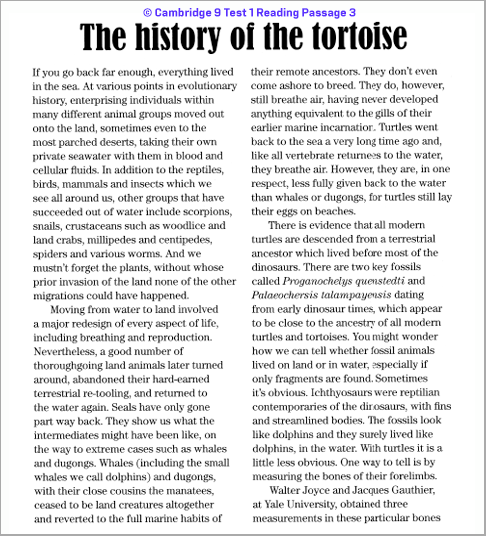

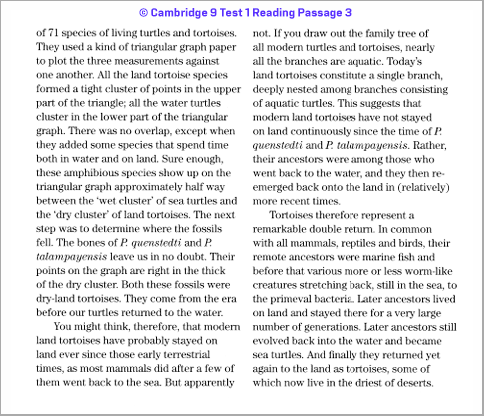

Let’s have a look at the questions from this passage:


I’ll help you do the first question. Then, you will try to do the rest of the questions on your own.
- 71 species of living turtles and tortoises were examined and a total of ____________ were taken from the bones of their forelimbs.
Keywords for this question: 71 species, living turtles and tortoises, examined, bones, forelimbs,
In paragraph no. 4 we find the mention of ‘71 species of living turtles and tortoises’. So, we should read attentively to find our answer here. The writer says at the beginning of paragraph no. 4, “Walter Joyce Jacques Gauthier, at Yale University, obtained three measurements in these particular bones (of their forelimbs as mentioned at the end of paragraph no. 3) of 71 species of living turtles and tortoises.”
So, the answer is: 3/three measurements
Remember, the rest of the questions will follow a sequence. Try to answer them accordingly as explained above in the strategies. Don’t look at the answers now. Find the answers at the end of the post when you are done with the questions.
Special tips on time management in IELTS Reading:
Most of the candidates, who find IELTS Reading the most challenging module, find it difficult to answer all the 40 questions within 60 minutes. It is their biggest fear for the exam. Many of the candidates ask me regularly about how to manage their time in this module.
Here are some tips that can work successfully for you.
1. Don’t try to read every word. Try to skim.
If you try to read word by word, you will surely waste your time and it will do no good for you. IELTS Reading is an exam of reading skills, not perfect reading. So, try learning skimming and speed-reading as much as you can before the exam.
2. Preview and predict.
These two skills can help you get a general idea about the whole text. It has been shown in different researches that our brain tries to create a picture of what we read. Reading skills such as previewing and predicting content can help you create this mental image. One other thing that you can do is to read all the questions quickly.
3. Mark or underline any specific information.
Use your pencil effectively. Always underline/mark important information even though they aren’t necessary for the question you are doing. They might appear useful later on. Besides, marking or underlining helps you remember the information in those particular lines.
3. Learn synonyms from different IELTS practice tests.
There is no alternative to learning new vocabulary if you want to save time. However, if you have a very limited time to prepare, you can try learning vocabulary from IELTS texts from the Cambridge IELTS series books. I did it and it really helped me in speed-reading.
4. Use a timer while practicing.
This is probably one of the most effective things that you can get habituated at. When you practice IELTS Reading, always try to use a timer. Suppose you are going to practice answering Reading Passage 1 from a complete test. Set your timer to 16 or 17 minutes; then start answering the questions. DO THIS FOR EVERY PRACTICE THAT YOU DO.
5. When stuck in one question, move on to the next one.
When you’ve spent around 80 seconds in one question and you haven’t been able to locate the answer, just move on to the next question. You cannot be with one question for too long. You can always come back to the question after answering the others.
6. Learn which question types follow a sequence and which don’t. Answer those questions first that follow a sequence.
Some questions like ‘Identifying information’ and ‘Classifying’ don’t follow any sequence. You should practice answering them after answering other questions (that follow sequence) in a passage. This may save some important time for you.
7. Mark titles in different questions (summary completion, diagram completion etc.).
Some questions such as summary completion, diagram completion etc. may have a title. This title can save some time for you if you are careful to mark them. They guide you to find the concerning paragraphs where you can find the answers.
8. Remember that some sentences may provide answer to more than one question.
This is where you can save some time too. Some questions may focus on the same sentence that you are going to read in the exam. So, you need to remember what you’ve read in those sentences because you’ve probably read the answer to another question from the same sentence.
9. Transfer the answers to the answer sheet when you find them instantly.
When you find the answer to the first question, transfer it to the answer sheet instantly. Remember, you don’t have any extra time for transferring your IELTS reading answers. If you are not so sure about an answer, you can always erase them with an eraser and write down the new answer.
I hope the post helps you in your IELTS Reading preparation and most importantly, in your exam. If you want to share your ideas of answering IELTS Reading questions or have tips for other candidate, please share them in the comments section.
Answers to the questions you practiced:
Answers for KEYWORD practice: Desert: A place of extreme
- soil 3. 50°C/122°F
Answers for MCQs: Music and the Emotions
- B 2. C 3. A 4. B 5. D
Answers for Short Answer to Open Questions: Stepwells
- pavilions 2. drought 3. tourists
Answers for TRUE, FALSE, NOT GIVEN: Stepwells
- NOT GIVEN 5. TRUE
Answers for List of Headings: The Developments of Museums
- vi 4. i 5. iii
Answers for Completing sentences: Let’s go bats
- radio waves/echoes 3. mathematical theories 4. zoologist
Answers for Identifying information: Let’s go bats
- A 3. A 4. E 5. D
Answers for Classifying information with correct group / Matching reference: A Chronicle of Timekeeping
- F 3. D 4. A
Answers for Completing table: The coconut palm
- sugar 3. ropes 4. charcoal 5. bowls 6. hormones 7. cosmetics 8. dynamite
Answers for Summary completion: Oxytocin
- childbirth 23. placebo 24. game 25. strangers 26. names
Answers for Labeling diagram: A Chronicle of Timekeeping
- (escape) wheel 11. tooth 12. (long) pendulum 13. second
Answers for Completing flow-chart: The history of the tortoise
- (triangular) graph 36. cluster 37. amphibious 38. half way 39. dry-land tortoises

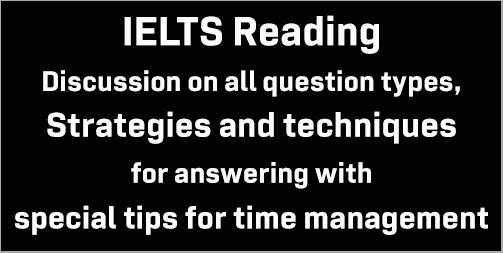


Assalam- o -allaikum! Sir, I have completed my pre- engineering exams with 980 mark I want to get 7 bands in 1 month.So,please tell me what should I do. My main problem is reading!
Dear Umar,
Please mail me all your problems with IELTS at the following address.
ieltsdeal@gmail.com
Hey, You are just Amazing, for Beginners like me found vast information under the cap.
Thanks alot